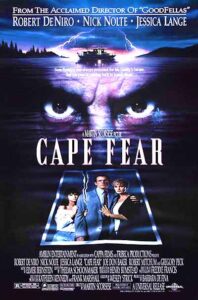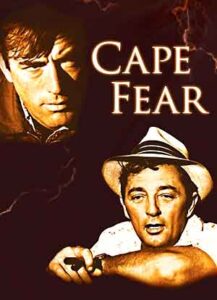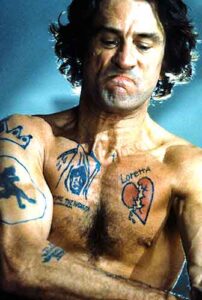 Back in 1991 this Martin Scorsese film seemed an anomaly: an unabashedly commercial thriller, and a remake to boot. The film has many good things, but just as many not-so-good ones.
Back in 1991 this Martin Scorsese film seemed an anomaly: an unabashedly commercial thriller, and a remake to boot. The film has many good things, but just as many not-so-good ones.
The original 1962 CAPE FEAR was a slick and compact adaptation of a 1957 John D. MacDonald novel, starring Gregory Peck as an upstanding lawyer and Robert Mitchum as a psychotic rapist determined to take Peck down for putting him away. Directed by J. Lee Thompson, the film is a taut and terrific grade-B thriller that was also something of an envelope-pusher; the climax wherein Mitchum smears egg paste on actress Polly Bergen’s chest was particularly shocking to audiences of the time. Martin Scorsese, America’s greatest contemporary director, calls the original CAPE FEAR “a perfect B film…a perfect film noir, and you can’t do that again.”
Martin Scorsese…calls the original CAPE FEAR “a perfect B film…a perfect film noir…”

Cape Fear Trailer, 1962
Yet Scorsese ended up helming this remake, prodded by his frequent collaborator Robert De Niro, who headlined the film. Steven Spielberg was the (uncredited) executive producer and Gregory Peck and Robert Mitchum turned up in supporting parts (with, in a reversal of their roles in the original film, Mitchum playing a good guy and Peck a not-so-good one). The film, released in November of 1991, was a solid commercial hit, and jump-started Scorsese’s post-1991 career.
The film, released in November of 1991, was a solid commercial hit, and jump-started Scorsese’s post-1991 career.
Cape Fear Trailer, 1991
Max Cady is a psychotic rapist who’s bulked himself up and tattooed his body with a dozen or so Biblical verses. His aim is to turn himself into “something more than human.” Upon being released from a Georgia prison Cady tracks down his lawyer, one Sam Bowden. Cady blames Sam for putting him away, as the latter deliberately suppressed evidence in his trial.
Cady harasses Sam, along with his wife and teenage daughter Danielle, by acting obnoxious in a movie theater, sitting on the fence outside their home and poisoning their dog. Sam files a restraining order, to which Cady responds by picking up and brutalizing a woman with whom Sam is having an affair.
To my mind CAPE FEAR occupies the same place in the Scorsese pantheon as THE LAST TEMPTATION OF CHRIST and KUNDUN…
Next Cady instigates a decidedly creepy encounter with Danny in her school basement. This drives Sam over the edge, and he hires some tough guys to rough up Cady. The latter, alas, withstands the brutality and beats up his abusers.
Sam pretends to leave town and so lure Cady to his house. A cop friend is stationed in the house with a gun but Cady busts in with ease, killing the cop and also the Bodens’ live-in maid.
Sam decides (unwisely) the only remaining option for the Bowdens is to drive off to the family houseboat, moored in the appropriately monikered Cape Fear. But Sam is unaware that Cady has attached himself to the bottom of his car, and so is going with them to Cape Fear, and a nightmarish showdown amid a monster storm.
To my mind CAPE FEAR occupies the same place in the Scorsese pantheon as THE LAST TEMPTATION OF CHRIST and KUNDUN: an interesting but flawed experiment that sees Scorsese working outside his comfort zone. That explains the awkwardness of the film, decked out with visual quirks that are distracting and show-offy (unlike Scorsese’s previous effort GOODFELLAS, where the stylistic extravagance was smoothly integrated into the whole). The same goes for the overbearing Christian symbolism, which is heavy handed and gratuitous. Another annoyance is the remixed music, taken from Bernard Herrmann’s original score, which feels consistently out of place and plain weird. Back in 1991 THE DEPARTED and SHUTTER ISLAND were several years in the future; commercial moviemaking was something Scorsese hadn’t yet perfected.
Yet the film is undeniably exciting, intense, and surprisingly gory. This CAPE FEAR may be a commercial exercise whose primary intent was to put asses in seats, yet Scorsese was fully engaged with the material. He and screenwriter Wesley Strick also subtly inverted the conservative outlook of the original film and source novel by making the protagonist a less-than-honorable individual who engages in court misconduct, screws around on his wife and can’t control his teenage daughter. There’s even a feminist message, with Sam’s fuckmate (played by Scorsese’s then-girlfriend Illeana Douglas) scared to testify against Cady because of society’s attitudes toward promiscuous women.
…Scorsese was fully engaged with the material.
Acting-wise the film belongs to Robert De Niro, who makes for a great over-the-top villain, and a then-unknown Juliette Lewis as the teenage Danielle. Their sexually-tinged meeting on a school stage is the film’s most striking sequence, and certainly the creepiest. Neither of the stars Nick Nolte or Jessica Lange make much of an impression, unfortunately, but then the true “star” of this film was behind the camera, and CAPE FEAR is a worthy, if flawed, addition to that star’s distinguished repertoire.
Vital Statistics
CAPE FEAR
Universal Pictures
Director: Martin Scorsese
Producer: Barbara De Fina
Screenplay: Wesley Strick
(Based on a novel by John D. MacDonald)
Cinematography: Freddie Francis
Editing: Thelma Schoonmaker
Cast: Robert De Niro, Nick Nolte, Jessica Lang, Joe Don Baker, Juliette Lewis, Robert Mitchum, Gregory Peck, Illeana Douglas, Martin Balsam, Fred Dalton Thompson, Zully Montero

